Lesson 30 Personal Computer电子技术专业英语教程
- 格式:ppt
- 大小:322.50 KB
- 文档页数:37
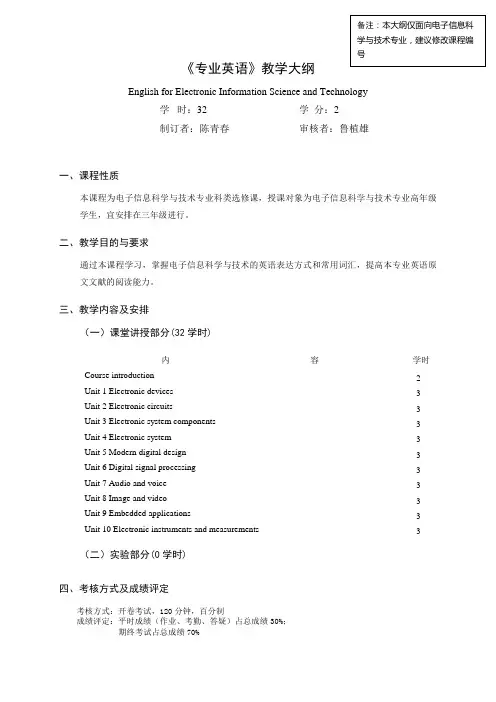
《专业英语》教学大纲English for Electronic Information Science and Technology学 时:32学 分:2 制订者:陈青春审核者:鲁植雄一、课程性质本课程为电子信息科学与技术专业科类选修课,授课对象为电子信息科学与技术专业高年级学生,宜安排在三年级进行。
二、教学目的与要求通过本课程学习,掌握电子信息科学与技术的英语表达方式和常用词汇,提高本专业英语原文文献的阅读能力。
三、教学内容及安排(一)课堂讲授部分(32学时)内 容学时 Course introduction 2 Unit 1 Electronic devices 3 Unit 2 Electronic circuits3 Unit 3 Electronic system components 3 Unit4 Electronic system 3 Unit5 Modern digital design 3 Unit6 Digital signal processing 3 Unit7 Audio and voice 3 Unit8 Image and video 3 Unit9 Embedded applications3 Unit 10 Electronic instruments and measurements3(二)实验部分(0学时)四、考核方式及成绩评定考核方式:开卷考试,120分钟,百分制成绩评定:平时成绩(作业、考勤、答疑)占总成绩30%; 期终考试占总成绩70%五、教材与参考书(一)教材1.任治刚编,《电子信息工程专业英语》,2004年,电子工业出版社,第一版(二)参考书1.李白萍编,《电子信息类专业英语》,2004年,西安电子科技大学出版社,第一版。
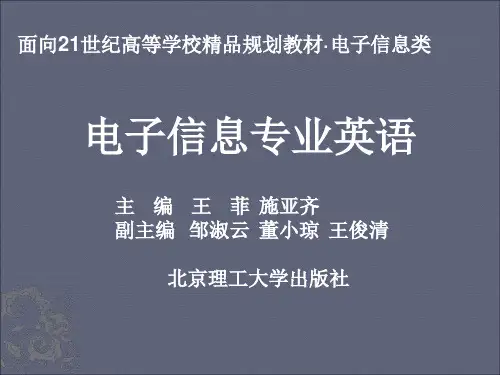

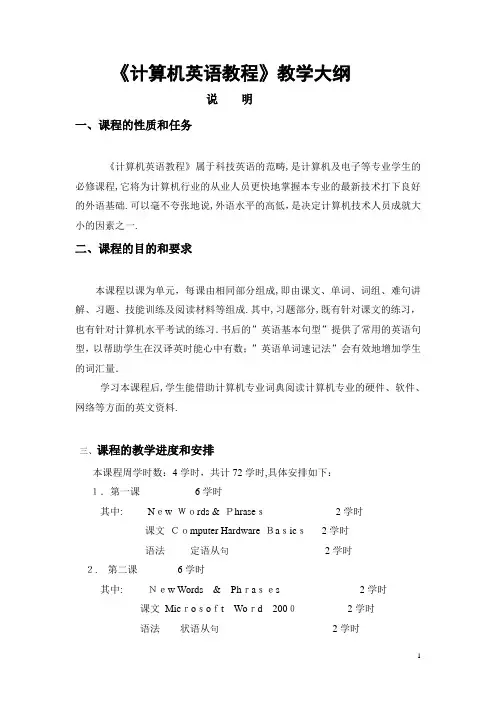
《计算机英语教程》教学大纲说明一、课程的性质和任务《计算机英语教程》属于科技英语的范畴,是计算机及电子等专业学生的必修课程,它将为计算机行业的从业人员更快地掌握本专业的最新技术打下良好的外语基础.可以毫不夸张地说,外语水平的高低,是决定计算机技术人员成就大小的因素之一.二、课程的目的和要求本课程以课为单元,每课由相同部分组成,即由课文、单词、词组、难句讲解、习题、技能训练及阅读材料等组成.其中,习题部分,既有针对课文的练习,也有针对计算机水平考试的练习.书后的”英语基本句型”提供了常用的英语句型,以帮助学生在汉译英时能心中有数;”英语单词速记法”会有效地增加学生的词汇量.学习本课程后,学生能借助计算机专业词典阅读计算机专业的硬件、软件、网络等方面的英文资料.三、课程的教学进度和安排本课程周学时数:4学时,共计72学时,具体安排如下:1.第一课6学时其中:New Words & Phrases2学时课文Computer Hardware Basics2学时语法定语从句2学时2.第二课6学时其中: New Words&Phrases 2学时课文Microsoft Word20002学时语法状语从句2学时3.第三课6学时其中:New Words & Phrases 2学时课文Microsoft Outlook 20002学时语法动词不定式2学时4.第四课6学时其中: New Words&Phrases2学时课文Unix History2学时语法现在分词2学时5. 第五课6学时其中:NewWords &Phrases 2学时课文Windows NT and Viruses2学时语法过去分词2学时6.第六课6学时其中: NewWords& Phrases2学时课文 C Language2学时语法动名词2学时7. 第七课6学时其中:New Words& Phrases 2学时课文Reports on SecurityFlawsinCommerciallyAvailable Software C 2学时语法倒装句2学时8. 第八课6学时其中: New Words& Phrases2学时课文Opera:Browsingto a DifferentTune 2学时语法it的用法2学时9. 第九课6学时其中:New Words&Phrases2学时课文DOT-COM ASPs: TheNextGeneration 2学时语法被动语态2学时10. 第十课6学时其中: New Words &Phrases2学时课文Home NetworkingAin’t Easy---OneMan’s Story2学时语法介词2学时11. 第十一课6学时其中: New Words& Phrases2学时课文Processing XML With Perl 2学时语法数词2学时12. 第十二课6学时其中:New Words&Phrases 2学时课文ConcerningHackerswho Break intoComputerSystems2学时语法同位语和插入语数词2学时大纲内容一、计算机专业词汇的学习(24学时)(一)目的和要求1.主要掌握计算机专业方面的词汇.2.复习并掌握基础英语的普通常用词汇.3.(二)主要内容1.计算机专业的硬件方面的词汇.2.计算机专业的程序设计、软件等方面的词汇.3.计算机病毒方面的词汇.4.计算机网络通信方面的词汇.二、计算机专业英语文章的精读(24学时)(一)目的和要求]1.精读12篇课文.2.掌握常用的科技英语文章的语法结构及其翻译方法.(二)主要内容1.计算机硬件基础.2.微软Word2003.3.微软Outlook 2003.4.Unix历史.5.WindowsNT及病毒.6.C语言.7.关于商务可用软件中安全缺陷的报告8.OPERA软件:浏览不同的节目9.DOT-COM ASPs:新的一代10.家庭网络技术不容易----一个人的故事11.关于商务可用软件中安全缺陷的报告12. 论攻入计算机系统的黑客三、计算机专业英语文章中的常用语法(24学时)(一)目的和要求]1.掌握计算机专业英语文章中的常用语法.(二)主要内容1.语法定语从句2.语法状语从句3.语法动词不定式4.语法现在分词5.语法过去分词6. 语法动名词7. 语法倒装句8.语法it的用法9.语法被动语态10. 语法介词11. 语法数词12.语法同位语和插入语附录一、说明1.应根据计算机技术的飞速发展,介绍新型硬件、软件、网络等方面的英文资料.2.课程内容可根据学生的外语程度适当减少.二、参考书1.《计算机英语教程》(司爱侠张强华编著)(电子工业出版社)2.《计算机专业英语》(刘乃琦编著)(电子工业出版社)3.《计算机英语》(刘兆毓主编)(清华大学出版社)。
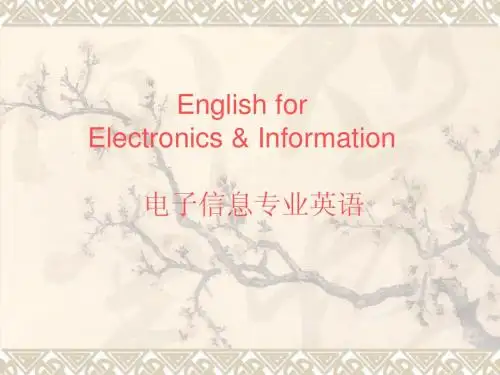
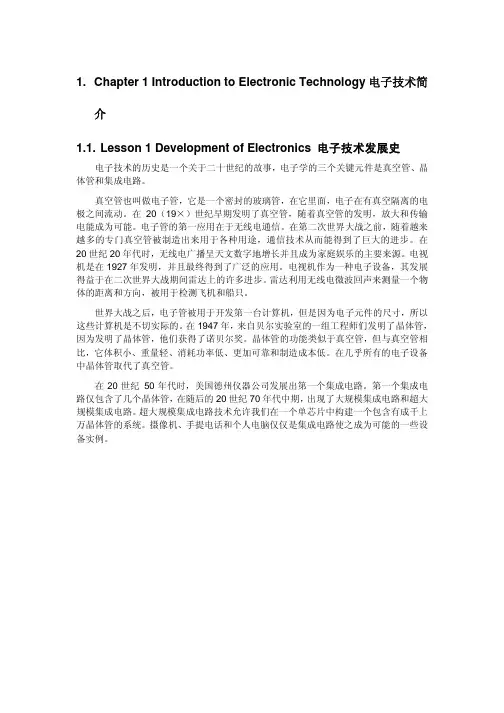
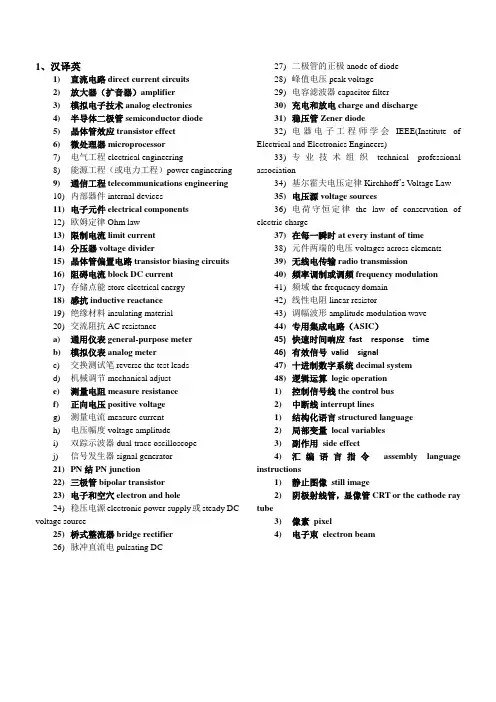
1、汉译英1)直流电路direct current circuits2)放大器(扩音器)amplifier3)模拟电子技术analog electronics4)半导体二极管semiconductor diode5)晶体管效应transistor effect6)微处理器microprocessor7)电气工程electrical engineering8)能源工程(或电力工程)power engineering9)通信工程telecommunications engineering10)内部器件internal devices11)电子元件electrical components12)欧姆定律Ohm law13)限制电流limit current14)分压器voltage divider15)晶体管偏置电路transistor biasing circuits16)阻碍电流block DC current17)存储点能store electrical energy18)感抗inductive reactance19)绝缘材料insulating material20)交流阻抗AC resistancea)通用仪表general-purpose meterb)模拟仪表analog meterc)交换测试笔reverse the test leadsd)机械调节mechanical adjuste)测量电阻measure resistancef)正向电压positive voltageg)测量电流measure currenth)电压幅度voltage amplitudei)双踪示波器dual-trace oscilloscopej)信号发生器signal generator21)PN结PN junction22)三极管bipolar transistor23)电子和空穴electron and hole24)稳压电源electronic power supply或steady DC voltage source25)桥式整流器bridge rectifier26)脉冲直流电pulsating DC27)二极管的正极anode of diode28)峰值电压peak voltage29)电容滤波器capacitor filter30)充电和放电charge and discharge31)稳压管Zener diode32)电器电子工程师学会IEEE(Institute of Electrical and Electronics Engineers)33)专业技术组织technical professional association34)基尔霍夫电压定律Kirchhoff’s V oltage Law35)电压源voltage sources36)电荷守恒定律the law of conservation of electric charge37)在每一瞬时at every instant of time38)元件两端的电压voltages across elements39)无线电传输radio transmission40)频率调制或调频frequency modulation41)频域the frequency domain42)线性电阻linear resistor43)调幅波形amplitude modulation wave44)专用集成电路(ASIC)45)快速时间响应fast response time46)有效信号valid signal47)十进制数字系统decimal system48)逻辑运算logic operation1)控制信号线the control bus2)中断线interrupt lines1)结构化语言structured language2)局部变量local variables3)副作用side effect4)汇编语言指令assembly language instructions1)静止图像still image2)阴极射线管,显像管CRT or the cathode ray tube3)像素pixel4)电子束electron beam2、英译汉1)assembler language汇编语言2)alternating current circuits交流电路3)passive electrical circuits无源电路4)three phase circuits三相电路5)digital electronics数字电子技术6)logic gates逻辑门7)3D virtual reality image三维虚拟图像8)computer programming计算机编程9)major in(在大学里)主修10)advanced programming techniques高级编程技术1)known as capacitive reactance称为容抗2)with units ohms单位为欧姆3)prevent device from burning out防止器件烧掉4)has an AC resistance to AC current对交流电流由阻抗5)adjustment with a screw用一个螺丝调节6)in the shape of a cylinder 呈圆柱形式7)block DC current,but pass AC current阻直流通交流8)to vary the inductance改变电感9)be given by the formula 由公式给出10)the RF amplifier 音频放大器1)analog multimeter模拟万用表2)extended range扩展范围3)specific meters特殊仪表4)includes the function and range switches具有功能及范围选择旋钮5)present an electronic picture呈现一幅电子图像6)display the voltage waveform显示电压波形7)appear on the screen在屏幕上出现8)phase relationships相位关系9)an example例如,作为一个例子10)in series with the circuit串连接入电路1)Semiconductor material半导体材料2)forward biased正向偏置3)depend on the external circuit resistance取决于外部电路的电阻4)excessive reverse-biased voltage过高的反偏电压5)is directly proportional to the amount ofbase current是正比于基极电流6)may even appear almost as a short几乎可看成是短路7)cause stability problems for a transistorcircuit引起晶体管电路的稳定性问题8)digital technology数字技术9)the most popular technology最常用的技术10)use two complementary typeset oftransistors N-channel and P-channel用两种互补型的晶体管——N沟道和P沟道1)equipment operation设备的运行2)device that converts AC into DC把交流电转换成直流电的器件3)the power lines电源线4)depending on the value of DC voltageneeded 根据所需要的直流电压值5) a half-wave rectifier平波整流器6)so as to produce a constant DC output从而产生一个稳定的直流输出7)in the negative side of the capacitor在电容的负极8)flow through the load流过负载9)in the forward-biased condition在加正向偏置电压的条件下10) a series(current-limiting)resistor一个串联(限制电流)电阻1)current source电流源2)under this circumstance在这种情况下3)present the second of Kirchhoff’s laws给出基尔霍夫第二定律4)introduce the concept of a “loop”引入“回路”的概念5)An alternative statement of KVLKVL的另一种表述法6)voltages algebraically sum电压代数和7)sinusoidal steady-syate response正弦稳态响应8)ordinary household voltage日常用电的电压9)time-invariant circuit时不变电路10)percentage of modulation调制百分比reduce the power consumption减小消耗功率flip-flop 触发器the octal and hexadecimal systems当时钟脉冲信号来到时改变状态①直流电路direct current circuits②放大器(扩音器)amplifier③欧姆定律Ohm law④正极positive electrode⑤充电与放电Charge and discharge⑥无线电传输Radio transmission⑦模拟仪表Analogue Meters⑧模拟电子技术analog electronics⑨半导体二极管semiconductor⑩晶体管效应transistor effect⑪微处理器microprocessor⑫通信工程telecommunications engineering ⑬汇编语言assembler language⑭电子元件electrical components⑮限制电流limit current⑯分压器voltage divider⑰偏置电路biasing circuits⑱阻碍电流block DC current⑲感抗inductive reactance⑳容抗capacitive21正向电压positive voltage22扩展范围extended range23电压波形voltage waveform24连接入电路in series with the circuit25PN结PN junction 26三极管bipolar transistor27电子与空穴electron and hole28半导体材料semiconductor material29正向偏置forward biased30数字技术digital technology31桥式整流器bridge rectifier32稳压管Zener diode33电源线the power lines34在电容的负极in the negative side of the capacitor 在加正向偏置的条件下in the forward-biased condition一个串联电阻 a series (current-limiting)resistor35电压源voltage sources36在每一瞬时at every instant of time37无线电传输radio transmission38频率调制或调频frequency modulation39快速时间响应fast response time40有效信号valid signal41结构化语言structured language42局部变量local variables43副作用side effect44静止图像still image45阴极射线管pixel46电子束electron beam1.resistors are used to limit current flowing to adevice ,thereby preventing it from burning out, as voltage dividers to reduce voltage for other circuits, as transistor biasing circuits, and to serve as circuit loads.电阻常用做限流器,限制流过器件的电流防止烧坏器件,电阻也可用作分压器,以减小其他电路电压,还可以用在晶体管偏执电路中和作为电路负载。

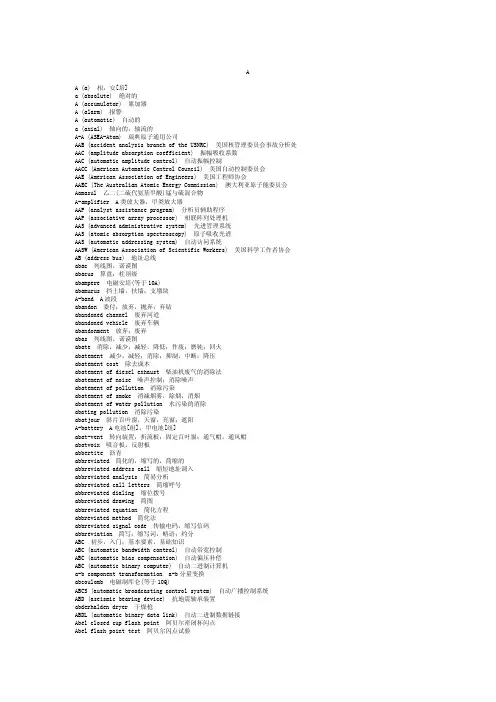

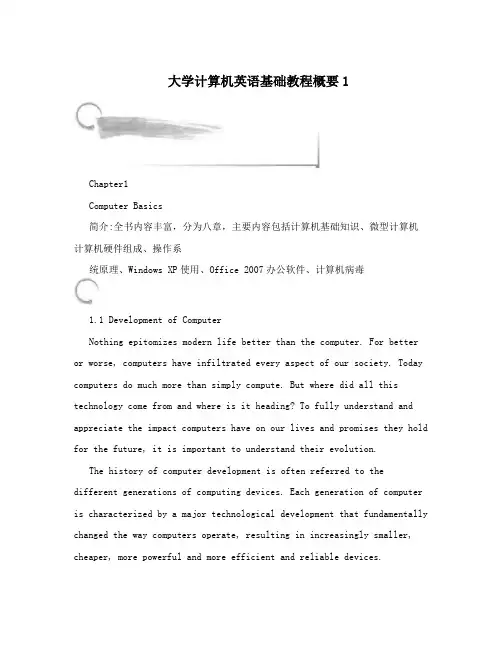
大学计算机英语基础教程概要1Chapter1Computer Basics简介:全书内容丰富,分为八章,主要内容包括计算机基础知识、微型计算机计算机硬件组成、操作系统原理、Windows XP使用、Office 2007办公软件、计算机病毒1.1 Development of ComputerNothing epitomizes modern life better than the computer. For better or worse, computers have infiltrated every aspect of our society. Today computers do much more than simply compute. But where did all this technology come from and where is it heading? To fully understand and appreciate the impact computers have on our lives and promises they hold for the future, it is important to understand their evolution.The history of computer development is often referred to thedifferent generations of computing devices. Each generation of computer is characterized by a major technological development that fundamentally changed the way computers operate, resulting in increasingly smaller, cheaper, more powerful and more efficient and reliable devices.Read about each generation and the developments that led to the current devices we use today.1.1.1 History of Computer1. First Generation (1940—1956)The first generation computers used vacuum tubes for circuitry and magnetic drums for memory, and were often enormous, taking up entire rooms (see figure 1.1). They were very expensive to operate and in addition to using a great deal of electricity, generated a lot of heat, which was often the cause of malfunctions.First generation computers relied on machine language, the lowest-level programming language understood by computers, to perform operations, and they could only solve one problem at a time. Input was based on punched cards and paper tape, and output was displayed on printouts.大学计算机英语基础教程 22. Second Generation (1956—1963)By 1948, the invention of the transistor greatly changed the computer?s development (seefigure1.2). The transistor replaced the large, cumbersome vacuum tube in televisions, radios and computers. As a result, the size of electronic machinery has been shrinking ever since. The transistor was at work in the computer by 1956. Coupled with early advances in magnetic-core memory, transistors led to second generation computersthat were smaller, faster, more reliable and more energy-efficient than their predecessors.(a)vacuum tube (b)ENIACFigure 1.1 First generation computerSecond generation computers moved from cryptic binary machine language to symbolic, or assembly, languages, which allowed programmers to specify instructions in words. High-level programming languages were also being developed at thistime, such as early versions of COBOL and FORTRAN.These were also the first computers that stored theirinstructions in their memory, which moved from amagnetic drum to magnetic core technology.3. Third Generation (1964—1971)The development of the integrated circuit (Jack Kilby, an engineer from Texas Instruments, developed the Figure 1.2 Transistor integrated circuit (IC) in 1958) was the hallmark of thethird generation of computers. Transistors were miniaturized and placed on silicon chips, called semiconductors, which drastically increased the speed and efficiency of computers.Instead of punched cards and printouts, users interacted with third generation computers through keyboards and monitors and interfaced with an operating system, which allowed the device to run many different applications at one time with a central program that monitored the memory. Computers for the first time became accessible to a mass audience because they were smaller and cheaper than their predecessors.Chapter 1 Computer Basics 34. Fourth Generation (1971—Present)The microprocessor brought the fourth generation of computers, as thousands of integrated circuits were built onto a single silicon chip. What in the first generation filled an entire room could now fit in the palm of the hand. The Intel 4004 chip, developed in 1971, located all the components of the computer—from the central processing unit and memory to input/outputcontrols—on a single chip.In 1981 IBM introduced its first computer for the home user, and in 1984 Apple introduced the Macintosh. Microprocessors also moved out ofthe realm of desktop computers and into many areas of life as more and more everyday products began to use microprocessors.As these small computers became more powerful, they could be linked together to form networks, which eventually led to the development ofthe Internet. Fourth generation computers also saw the development of GUIs, the mouse and handheld devices.5. Fifth Generation (Present and Beyond)Fifth generation computing devices, based on artificial intelligence, are still in development, though there are some applications, such as voice recognition, that are being used today. The use of parallel processing and superconductors is helping to make artificialintelligence a reality. Quantum computation and molecular and nanotechnology will radically change the face of computers in years to come. The goal of fifth-generation computing is to develop devices that respond to natural language input and are capable of learning and self-organization.1.1.2 Types of ComputersComputers come in a variety of types designed for different purposes, with different capabilities and costs.1. MicrocomputersA microcomputer is a computer that has a microprocessor chip as its CPU. They are often called personal computers because they are designed to be used by one person at a time. Personal computers are typically used at home, at school, or at a business.Personal computers come in two major varieties, desktop computersand laptop computers (see figure 1.3).(a) desktop computer (b) laptop computerFigure 1.3 Personal computer大学计算机英语基础教程 42. PDAs and Palmtop ComputersA Personal Digital Assistant (PDA) is a handheld microcomputer that trades off power for small size and greater portability (see figure 1.4). They typically use a touch-sensitive LCD screen for both output andinput (the user draws characters and presses icons on the screen with a stylus). They may use Windows CE or similar operating system for handheld devices.Figure 1.4 PDA3. Workstations/ServersA workstation is a powerful, high-end microcomputer (see figure 1.5). They contain one or more microprocessors. They may be used by a single-user for applications requiring more power than a typical PC (rendering complex graphics, or performing intensive scientific calculations).Figure 1.5 WorkstationAlternately, workstation-class microcomputers may be used as server computers that supply files to client computers over a network. In this respect, high-end workstations have essentially supplanted the role of minicomputers (see below).There are classes of computers that are not microcomputers. These include minicomputers, mainframes, and supercomputers.4. MinicomputersA minicomputer is a multi-user computer that is less powerful than a mainframe. The niche previously filled by the minicomputer has been largely taken over by high-end microcomputer workstations serving multiple users (see above).Chapter 1 Computer Basics 55. MainframesA mainframe computer is a large, powerful computer that handles the processing for many users simultaneously. Users connect to the mainframeusing terminals and submit their tasks for processing by the mainframe.A terminal is a device that has a screen and keyboard for input and output, but it does not do its own processing (they are also called dumb terminals since they can?t process data on their own). Mainframes are typically used in situations where a companywants the processing power and information storage in a centralized location. Mainframes are also now being used as high-capacity server computers for networks with many client workstations.6. SupercomputersA supercomputer is mainframe computer that has been optimized for speed and processing power(see figure1.6).Supercomputers are used for extremely calculation-intensive tasks such as simulating nuclear bomb detonations, aerodynamic flows, and global weather patterns..Figure 1.6 SupercomputerVocabularyepitomize /vt. 摘要,概括,成为……缩影vacuum tube /n. 真空管,电子管magnetic drum /n. 磁鼓malfunction /n. 故障punched card /n. 穿孔卡片printout /n. [计]打印输出transistor /n. [电子]晶体管cumbersome / adj. 讨厌的,麻烦的,笨重的machinery /n. [总称]机器,机械cryptic /adj. 秘密的,加密的,神秘的,隐藏的symbolic / adj. 象征的,符号的assembly /n. 集合,装配,集会,集结,汇编integrated circuit /n. 集成电路大学计算机英语基础教程 6hallmark / n. 特点miniaturize /vt. 使小型化silicon chip /n. 硅片semiconductor /n. [物]半导体operating system /n. 操作系统accessible /adj. 可访问的,可到达的,可理解的 central processing unit /n. 中央处理器memory /n. ? 记忆,记忆力,回忆,存储(器),存储器存储器,内存GUIs /n. [计]图形用户界面artificial intelligence /n. 人工智能voice recognition /n. 语音识别superconductor /n. 超导(电)体quantum /n. ? 量,额,[物]量子,量子论美国昆腾公司,是世界领先的硬盘生产商 laptop computer /n. 膝上型计算机desktop computer /n. 桌上型电脑Personal Digital Assistant (PDA) /abbr. 个人数字助理trade off /v. 交替换位,交替使用,卖掉 portability /n. 便携性,轻便icon /n. 图标,肖像,偶像workstation /n. 工作站client computer /n. [计]客户机supplant /vt. 排挤掉,代替minicomputer/n. 小型机mainframe /n. [计]主机,大型机niche /n. ? 壁龛(放雕像、花瓶等的墙壁凹处);【地质】雪凹(适合个人性格、能力等的)适当的位置,恰当的处所a niche in the temple of fame流芳百世,不朽的名誉find the right niche for oneself适得其所 simultaneously /adv. 同时地terminal /n. 终点站,终端,接线端 /adj. 末期,每期的,每学期的terminal point终点Chapter 1 Computer Basics 71.2 Basic Computer ComponentsA computer is an electronic device designed to accept data, perform prescribed mathematical and logical operations at high speed, anddisplay the results of these operations. Most computers have five types of hardware component: input, CPU, memory, storage and output (seefigure 1.7).Figure 1.7 Computer componentsInput devices accept data in a form that the computer can utilize. Also, the input devices send the data or instructions to the processing unit to be processed into useful information.The role of the processing unit or central processing unit is to use a stored program to manipulate the input data into the information required.The CPU is the brain of the computer. The CPU consists of electronic circuits that interpret and execute instructions; it communicates with the input, output, and storage devices. The CPU, with the help of memory, executes instructions in the repetition of machine cycles. A machine cycle consists of the following four steps.The control unit fetches an instruction and data associated withit from memory.The control unit decodes the instruction.The arithmetic/logic unit executes the instruction.The arithmetic/logic unit stores the result in memory.Memory, or primary storage, works with the CPU to hold instructions and data in order to be processed. Memory keeps the instructions and data for whatever programs you happen to be using at the moment. It is very important to know that memory can hold data only temporarily because it requires a continuous flow of electrical current. If current is interrupted, data is lost.大学计算机英语基础教程 8Since we have said that memory is in the form of chips and must maintain a constant flow of electricity, there must be a more permanent form of storage that does not depend on a constant flow of electricity. That form of storage is called secondary or auxiliary storage. Magnetic disk storage is a very popular type of secondary storage.Finally, the last component of a computer system is the output device. An output device displays the processed information to the user. The two most popular forms of output devices are the printer and the monitor. Monitor output is called softcopy; the printer displays output in a permanent manner, it is called hardcopy. Other types of output devices include voice output and music output devices.Vocabularyutilize /vt. 利用interpret /v. 解释,说明,口译,通译,认为是…的意思repetition /n. 重复,循环,复制品,副本machine cycle /n. 机器工作周期,计算周期fetch /vt. 接来,取来,带来,售得,引出,吸引,到达,演绎出/vi. 取物,绕道而行/n. 取得,拿,诡计decode /vt. 解码,译解arithmetic /n. 算术,算法logic /n. 逻辑,逻辑学,逻辑性interrupt /vt. 打断(正在说话或动作的人),中断,妨碍,插嘴/vi. 打断(别人的讲话或行动)/n. (发给电脑的)中断信号permanent /adj. 永久的,持久的auxiliary /adj. 辅助的,补助的1.3 Binary Numeral SystemWe should all be familiar with the decimal (or base-ten) number system. Recall that each digit within any given decimal number is associated with a weight. Furthermore, the value of that number is the sum of the digits after each has been multiplied by its weight. Notethat the digits range form 0,1,…,9. Just as the decimal system with itsten digits is a base-ten system, the binary number system with its 2 digits, …0? and …1? is a base-two system.Chapter 1 Computer Basics 91.3.1 Conversion to and from Other Numeral Systems1. Converting Binary to DecimalTo express the value of a given binary number as its decimal equivalent we just need to sum the digits after each has been multiplied by its associated weight.For example, convert (110101.1011) to decimal form. 2 543210–1–2–3–4Binary Weights 2 2 2 2 2 2 2 2 2 2Binary Number 1 1 0 1 0 1 1 0 1 1Decimal Value 32 16 0 4 0 1 0.5 0 0.125 0.0625Total: (53. 6875) 102. Converting Decimal Whole Numbers to BinaryWe may use the approach called the Repeated-Division-by-2 method shown in the example below.Step 1: divide the quotient by two and record the remainder.Step 2: repeat step (1) until the quotient is equal to zero.For example, 118, in binary, is 10Operation Remainder118/2 = 59 059/2 = 29 129/2 = 14 114/2 = 7 07/2 = 3 13/2 = 1 11/2 = 0 1NOTE: Reading the sequence of remainders from the bottom up gives the binary numeral (1110110). 213. Converting Decimal Fractions to BinaryThe techniques used to convert decimal fractions to binary are similar to the methods demonstrated previously to convert decimal whole numbers. We may use the repeated multiplication-by-2 method, repeatedly multiply the fraction by two, and record the carry, until the fraction product is zero.Consider the conversion of (0.3125) to binary. 10Operation Carry0.3125*2=0.625 01 十进制转换成二进制的方法与转换成八、十六进制相同,后面不再赘述。
《计算机专业英语》电子教程计算机专业英语,一些文章,专业性强Computer EnglishChapter 1 The History and Future of Computers 计算机专业英语,一些文章,专业性强Chapter 1 The History and Future of ComputersKey points: useful terms and definitions of computersDifficult points: describing the features of computers of each generation计算机专业英语1-2计算机专业英语,一些文章,专业性强Chapter 1 The History and Future of ComputersRequirements:1. The trends of computer hardware and software 2. Basic characteristics of modern computers 3. Major characteristics of the four generations of modern computers 4. 了解科技英语的特点,掌握科技英语翻译要点计算机专业英语1-3计算机专业英语,一些文章,专业性强Chapter 1 The History and Future of Computers1.1 The Invention of the ComputerNew WordsExpressions:computerlike a. 计算机似的vacuum tubes 真空管thousands of 成千上万的electromechanical a. 机电的, 电机的Census Bureau 人口普查局known as 通常所说的,以……著称Abbreviations:ENIAC(Electronic Numerical Integrator and Computer) 电子数字积分计算机,ENIAC计算机EDSAC (Electronic Delay Storage Automatic Computer) 延迟存储电子自动计算机BINAC (Binary Automatic Computer) 二进制自动计算机UNIVAC (Universal Automatic Computer) 通用自动计算机计算机专业英语1-4计算机专业英语,一些文章,专业性强Chapter 1 The History and Future of Computers1.1 The Invention of the ComputerIt is hard to say exactly when the modern computer was invented. Starting in the 1930s and through the 1940s, a number of machines were developed that were like computers. But most of these machines did not have all the characteristics that we associate with computers today. These characteristics are that the machine is electronic, that it has a stored program, and that it is general purpose.很难确切地说现代计算机是什么时候发明的。
电子科学与技术专业专业英语教学大纲目录专业英语1教学大纲1一、课程开设目的与要求2二、教学中应注意的问题2三、课程内容及学时分配2Chapter 1Semiconductors Physics2Chapter 2Semiconductor Device2Chapter 3Processing Technology3Chapter 4Integrated Circuits3Chapter 5Microeleclromechanical Systems (MEMS)3Chapter 6Examples of Scientific and Technological Papers3四、授课学时分配4五、教材及参考书目4一、课程开设目的与要求电子科学与技术专业英语是电子科学与技术专业的一门专业必修课程。
主要目标是培养学生以英语为工具获取专业信息,及应用英语进行口头、书面专业交流的能力。
通过本课程的学习,使学生学习专业英语的常用语法和惯用法;掌握电子科学与技术领域常用的专业词汇、术语和缩略词;了解电子科学与技术专业领域的最新技术和发展动向;掌握基本的专业英语阅读和翻译技巧,为毕业后阅读专业英文文献打下良好的基础,培养学生能够借助工具阅读电子科学与技术专业书籍,并能够对相关资料进行翻译的能力。
二、教学中应注意的问题1.专业英语的先修课程:大学英语、大学物理、高等数学、电磁场、集成电路设计等;2.本课程教学应采用互动式的教学方式。
即通过将示范讲解和课上练习相互结合的方式,既能够调动学生们学习的主动性,也可以及时检查学生的学习效果。
示范讲解着重专业术语和句子的理解,重点培养学生的专业文献阅读能力和翻译能力。
三、课程内容及学时分配Chapter 1 Semiconductors Physics重点内容:学习半导体物理中的常用词汇和专业术语。
了解阅读的基本要素和基本的阅读方法。
基本要求:1.掌握半导体物理学中的常用词汇和专业术语;2. 了解阅读的基本要素和基本的阅读方法。